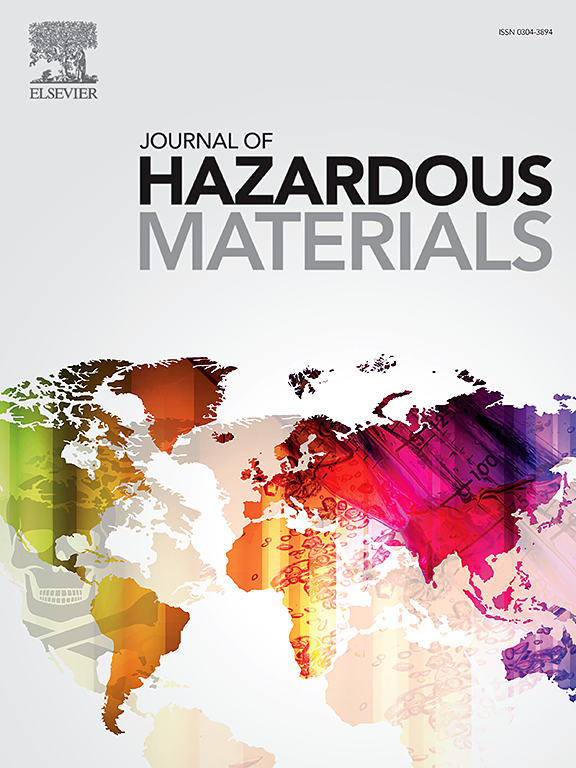基于MultiMP综合评价法的黄河河南段水体和沉积物微塑料污染
IF 12.2
1区 环境科学与生态学
Q1 ENGINEERING, ENVIRONMENTAL
引用次数: 0
摘要
以河南河段为研究对象,对黄河中下游微塑料污染现状及生态风险进行了调查。采用先进的多聚磷风险评价方法,对地表水和底泥环境进行了综合评价。结果表明,两种环境均检测到MPs,地表水丰度在3.35 ~ 12.6 n/L之间,沉积物丰度在206 ~ 1647 n/kg之间。从MPs的主要特征来看,最常见的粒径范围为25 ~ 150 μm;纤维状形态在地表水和沉积物中最为丰富;透明MPs在颜色方面的比例最高;在聚合物组成上,地表水中以聚乙烯(PE)和聚丙烯(PP)为主,沉积物中以聚乙烯(PE)和聚对苯二甲酸乙二醇酯(PET)为主。此外,还研究了影响MP分布的环境因素。地表水中MPs丰度与总磷(WTP)和总氮(WTN)密切相关,沉积物中MPs丰度与沉积物粒度密切相关。多聚磷评价结果表明,黄河流域河南段地表水为中等风险,大部分沉积物为高风险,两种环境的主要影响因素不同。这些发现填补了区域研究空白,为有效治理黄河流域多聚污染物提供了数据支持和理论基础。本文章由计算机程序翻译,如有差异,请以英文原文为准。

Microplastic pollution in water and sediment in the Henan section of the Yellow River based on the MultiMP comprehensive evaluation method
This study investigates the current state of microplastic (MP) pollution and ecological risks in the middle and lower reaches of the Yellow River, focusing on the Henan section. Using the advanced MultiMP risk assessment method, both surface water and sediment environments were comprehensively evaluated. Results indicate that MPs were detected in both environments, with surface water abundance ranging from 3.35–12.6 n/L and sediment abundance from 206–1647 n/kg. In terms of the main characteristics of MPs, the most common particle size ranged from 25 to 150 μm; fibrous shapes were the most abundant in both surface water and sediments; transparent MPs had the highest proportion in terms of color; and in terms of polymer composition, polyethylene (PE) and polypropylene (PP) were the main polymers found in surface water, while PE and polyethylene terephthalate (PET) were more common in sediments. Environmental factors influencing the MP distribution were also investigated. The abundance of MPs in surface water was closely related to total phosphorus (WTP) and total nitrogen (WTN), while the abundance of MPs in sediments was closely associated with the sediment particle size. MultiMP assessment results show medium risk for surface water and high risk for most sediments in the Henan section of the Yellow River Basin, with differing main factors affecting risk levels in the two environments. These findings fill regional research gaps and provide data support and theoretical foundations for effective MP pollution management in the Yellow River Basin.
求助全文
通过发布文献求助,成功后即可免费获取论文全文。
去求助
来源期刊

Journal of Hazardous Materials
工程技术-工程:环境
CiteScore
25.40
自引率
5.90%
发文量
3059
审稿时长
58 days
期刊介绍:
The Journal of Hazardous Materials serves as a global platform for promoting cutting-edge research in the field of Environmental Science and Engineering. Our publication features a wide range of articles, including full-length research papers, review articles, and perspectives, with the aim of enhancing our understanding of the dangers and risks associated with various materials concerning public health and the environment. It is important to note that the term "environmental contaminants" refers specifically to substances that pose hazardous effects through contamination, while excluding those that do not have such impacts on the environment or human health. Moreover, we emphasize the distinction between wastes and hazardous materials in order to provide further clarity on the scope of the journal. We have a keen interest in exploring specific compounds and microbial agents that have adverse effects on the environment.
 求助内容:
求助内容: 应助结果提醒方式:
应助结果提醒方式:


